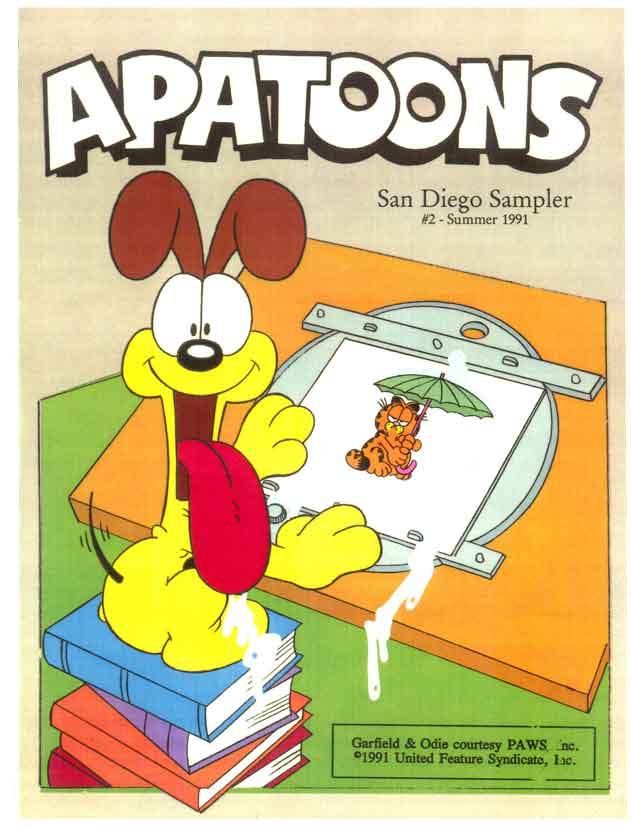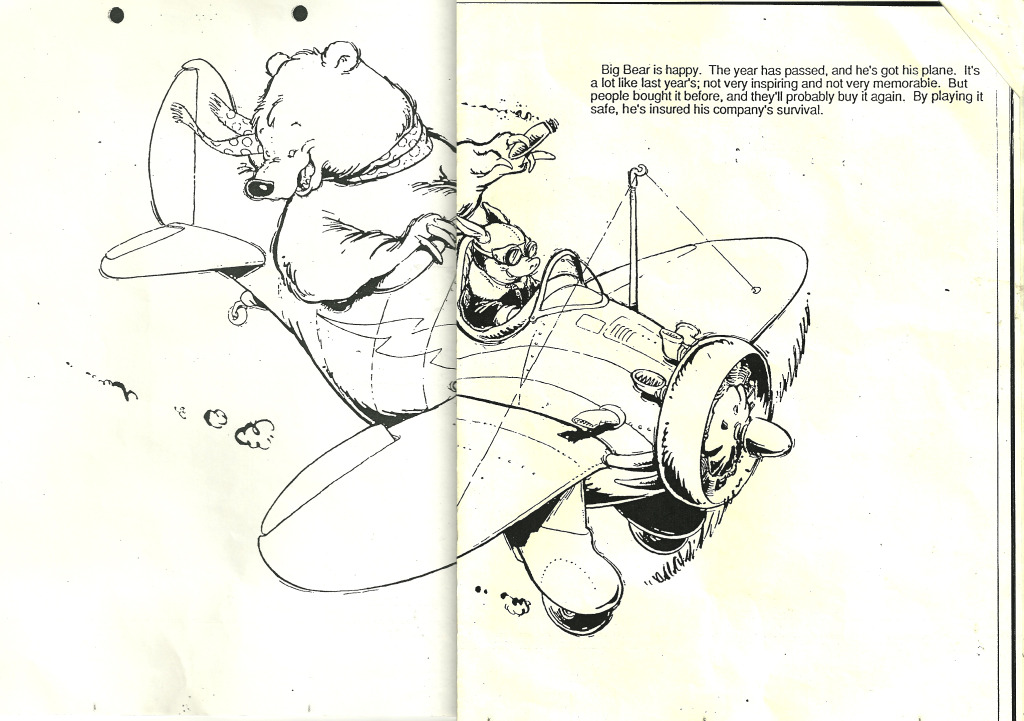Inspired by Popeye?
“Let’s You and Him Fight” is a 1934 Fleischer Popeye cartoon, in which the Sailor Man battles Bluto the Champ in a prize fight. Note what happens at 3:32.
http://youtu.be/fz6X8g754oE#t=3m32s
Bluto is pummeling Popeye. The bell rings. The characters take a break. The bell rings. The fight resumes.
Seems familiar?
In the Ralph Wolf and Sam Sheepdog cartoons by Chuck Jones, the characters are blue collar workers ruled by the time clock. When it whistles, Sam stops punishing Ralph. They take a break. The clock whistles again, Sam resumes punishing Ralph.
As they do in “A Sheep in the Deep,” 1962, at 3:40:
https://www.youtube.com/watch?v=uo7JNvVTMf8#t=3m40s
Jymn Magon Explodes Story Outlines
Jymn Magon, co-creator of Disney’s Adventures of the Gummi Bears, is a talented producer and storyteller whose website can be found here.
When writing for television, writers develop a script beginning with springboard, then progressing with premise, outline, first draft script and final draft script.
Jymn examines the outline phase in this enlightening article here.
He calls it “Exploding Your Outline.”
Thirty Years of APATOONS
Thirty years ago, animation fans Don Markstein and GiGi Dane began an amateur press association—an “apa”—devoted to the enjoyment and study of animated cartoons. This was APATOONS. A maximum of 30 members would send copies of their ‘zines to a Central Mailer, who would then circulate copies among the membership.
Copies were not made available to the public. Which meant that members could freely discuss how they felt about the animation scene, without fear of reprisal from those who might be offended. Members could also circulate essays for “fact-checking” and other feedback, before those essays would be published in venues such as Animato!, Comics Buyer’s Guide, and Animation World Network. It also served as a means of networking. Through it, some have obtained jobs in the animation industry.
APATOONS attracted the elite in animation scholarship. Members included animation historians Jim Korkis, Jerry Beck, Amid Amidi, Leonard Maltin, John Cawley, Milton Gray, Mark Mayerson, Harry McCracken, David Gerstein, Mark Kausler, Emru Townsend, Eric Costello, Linda Simensky, Mark Evanier and many others. Evanier, in fact, designed our logo.
Jim Korkis wrote about the legacy of APATOONS for the APATOONS San Diego Sampler #3, which you can read here.
Once in awhile, the group would release its own Sampler issues to the public. These special issues featured articles with information available nowhere else. The APATOONS Sampler #3, for example, featured a treasure trove of research detailed here. It can be purchased through my online store, here.
This week, the final issue of APATOONS is being compiled. This is #165, marking the 30th anniversary of the apa’s existence. It will also be the final printed issue. The group is moving to a new venue that, shall we say, takes full advantage of the digital revolution.
It’s been my pleasure to be involved with this illustrious group. To all my APATOONS friends, I thank you all for the education and insights you’ve provided over the years. I wish you all well.
The Animation Swiss Army Knife
My good friend Lance Falk has just launched his website, here.
 Lance is known as Animation’s “Swiss Army Knife.” Why? Because he’s talented in nearly every facet of animation production. He’s handled the jobs of being a writer, prop designer, production assistant, model cleanup artist, model designer, series model coordinator, post production associate producer, post-producer supervisor, assistant art director and design coordinator. His credits encompass high-profile properties ranging from Bob the Builder to Dinotopia to Jonny Quest.
Lance is known as Animation’s “Swiss Army Knife.” Why? Because he’s talented in nearly every facet of animation production. He’s handled the jobs of being a writer, prop designer, production assistant, model cleanup artist, model designer, series model coordinator, post production associate producer, post-producer supervisor, assistant art director and design coordinator. His credits encompass high-profile properties ranging from Bob the Builder to Dinotopia to Jonny Quest.
In addition to his versatility, Lance is dedicated to his work. That is, he’s driven to produce quality work under the most rigorous production schedules, and he succeeds.
One of Lance’s best qualities as a producer, I think, is that when he notices what might be a flaw, he will not berate the artist. Rather, he will put a positive spin on it. The artist may realize the mistake, but without the shame of being degraded. Lance respects artists. He nurtures their talent. That’s because he, himself, is an artist as well as a writer and producer. He knows the value of morale and positive reinforcement. He encourages team spirit. He cares about animation and those who make it. This makes Mr. Falk a valuable commodity in the industry.
Learn more about Animation’s Swiss Army Knife here.
It is my pleasure to know Lance Falk and to recommend him. If you’re an animation executive or producer and need help on your project, Lance is your man. Contact him here.
Chris Sanders Talks About “Big Bear”
When Cartoon Brew called attention to The Big Bear Aircraft Company, written and illustrated by Chris Sanders, a number of readers responded including Sanders himself.
“Golly, ” Sanders wrote, “I never thought I’d see that thing on the internet. I really wish I could re-do those drawings right about now.
“I read some of the comments earlier, and I think I can provide some perspective as to what I was up to, and what was happening at the time I wrote this.”
Learn about what Sanders was up to here.
The Big Bear Aircraft Company
In 1989, Chris Sanders–who would later direct Lilo and Stitch and How to Train Your Dragon–wrote and illustrated a story that served as a metaphor for the animation industry.
Read it here.
Gary Kurtz: The Audience is Everyone
In researching for my Star Wars book, I find interesting comments all the time. Here’s an observation from producer Gary Kurtz. Interviewer John Brosnan asked how difficult it had been to make a movie that would appeal to both children and adults.
Kurtz’s reply:
“Well, it never used to be difficult at all. In fact, almost every film produced by Hollywood once was intended just for an audience–children might have liked them or adults did–but there wasn’t any real division of the market. But then we reached the point where there are films made only for children which adults can’t stand and films made only for adults that children aren’t allowed to watch. Obviously there are some stories that need telling that are really only for adults–I think that’s alright–but one of the reasons that Star Wars was so successful was because it was one of the only films to come out in a long while that both children and adults could to go see and enjoy on different levels at the same time.”
A great observation. For me, the best stories are those that appeal to both adults and children.
Publishers and studios like to “target the audience” for specific age groups, ethnicity or gender, to better market the product.
But I agree with Kurtz. Why not write stories that appeal to everyone?
Source: John Brosnan, Starburst #25, v. 3, n. 1, (September) 1980, THE STAR WARS INTERVIEWS: PART THREE–“Gary Kurtz,” pp. 16-20 (16-17).





















